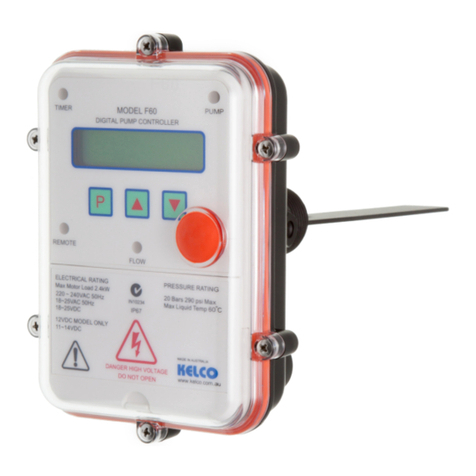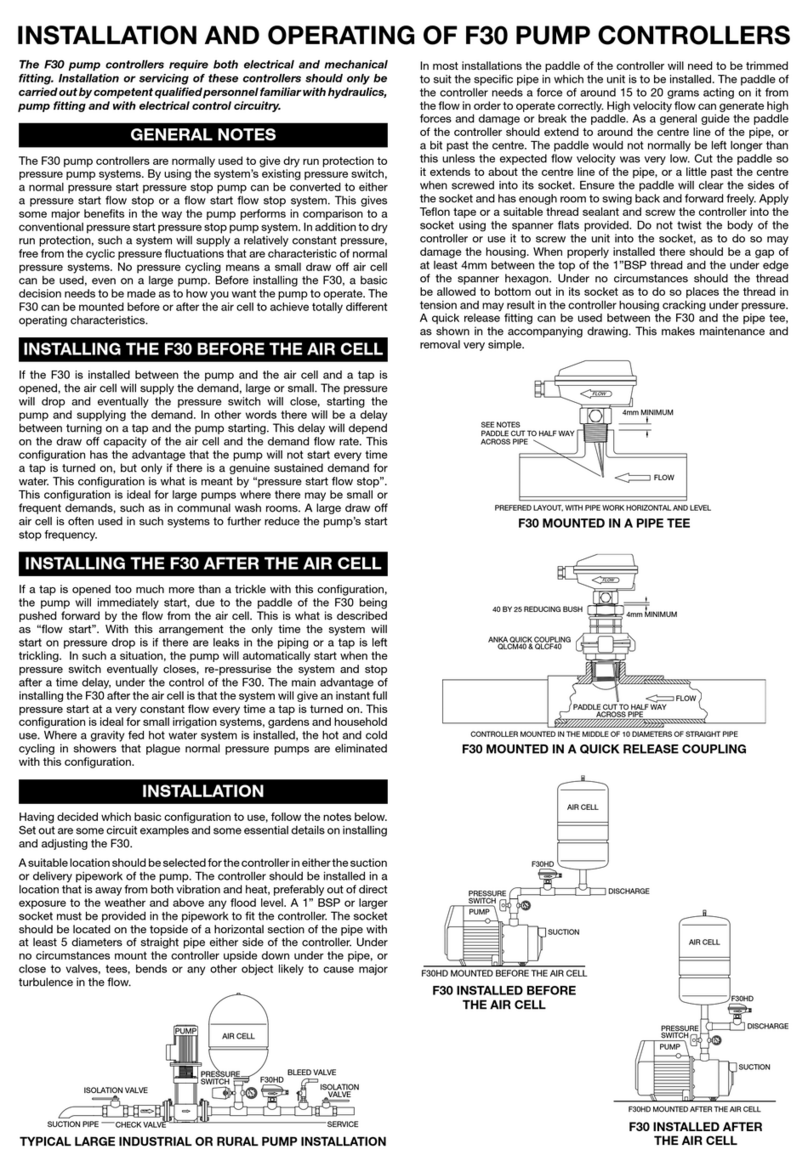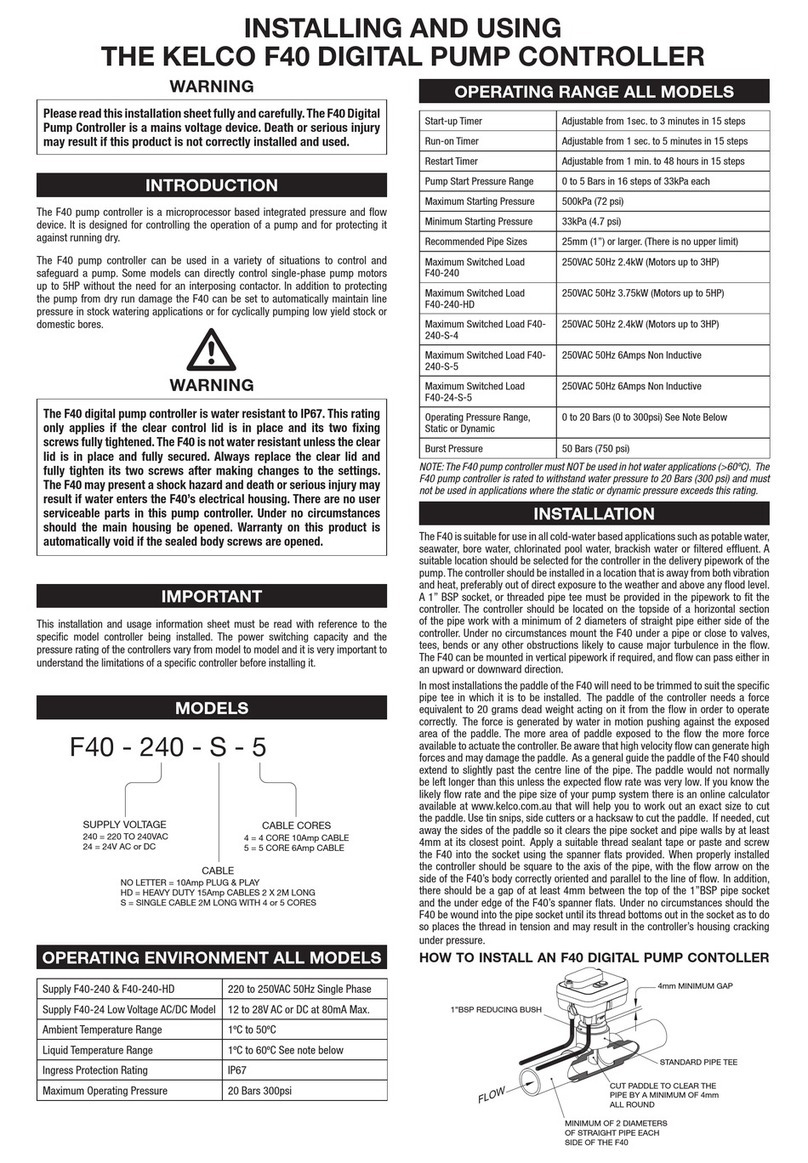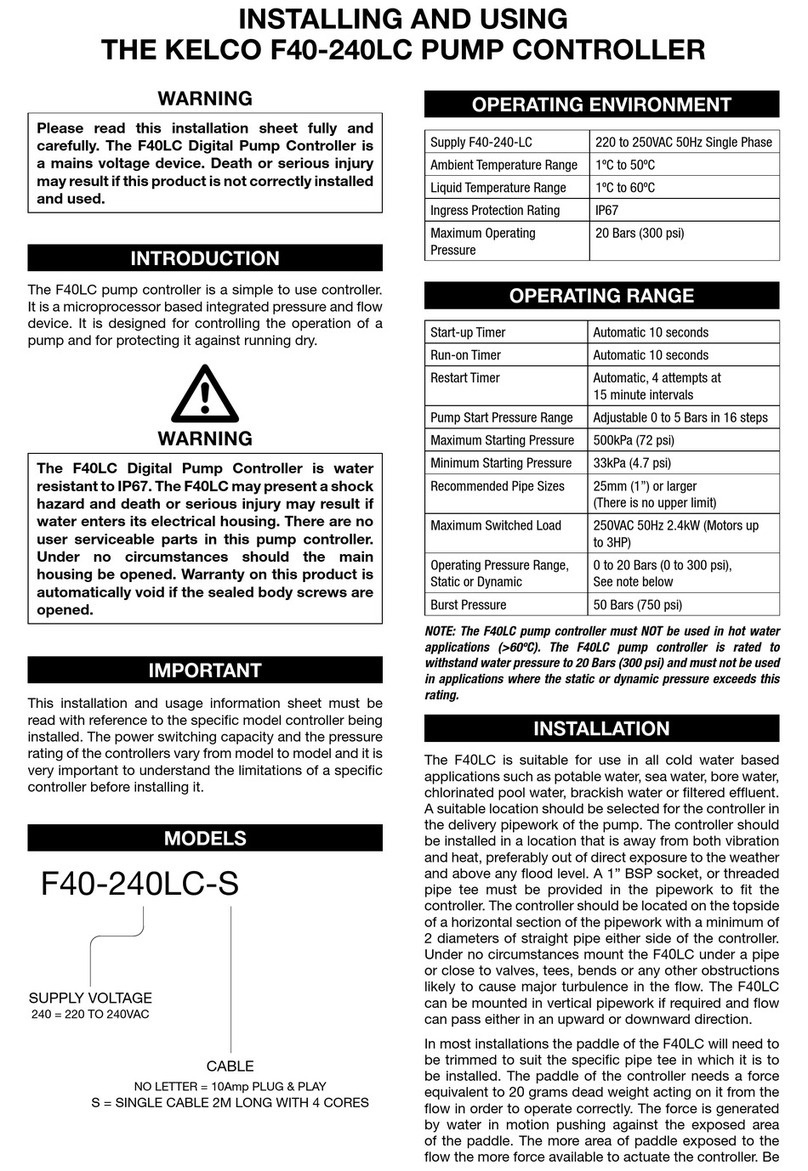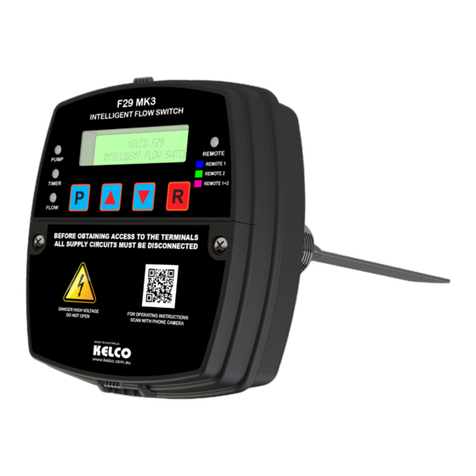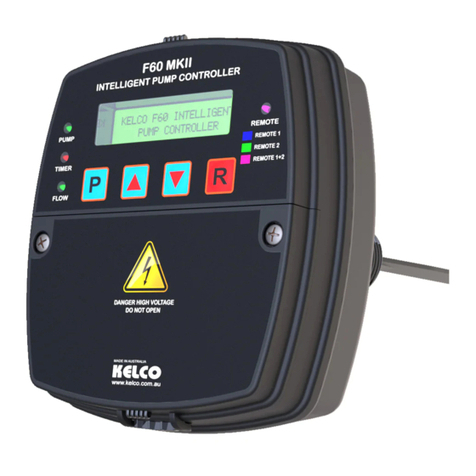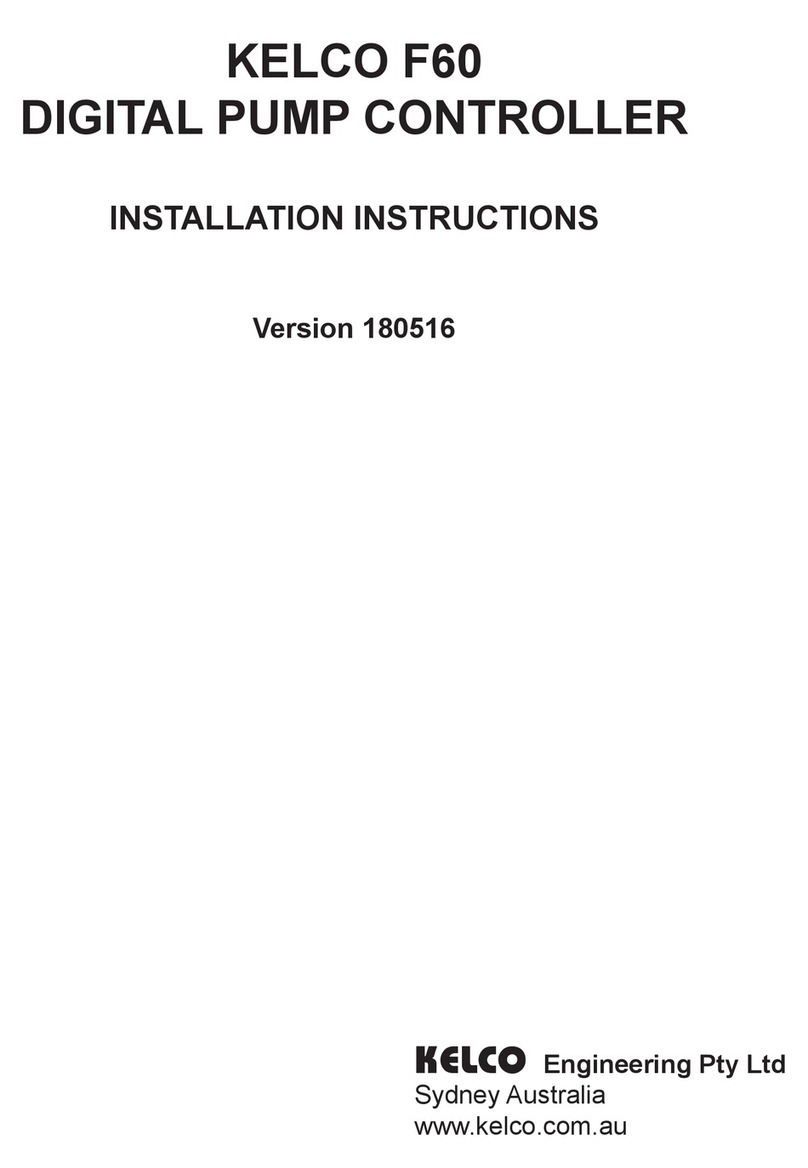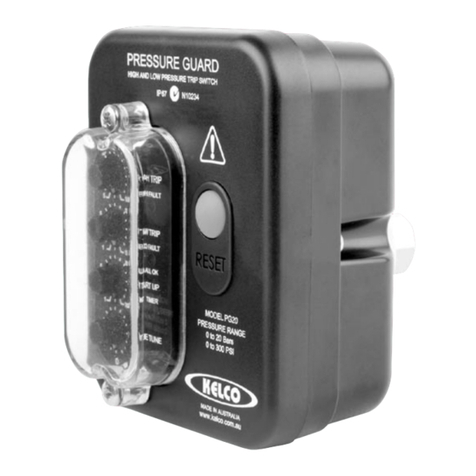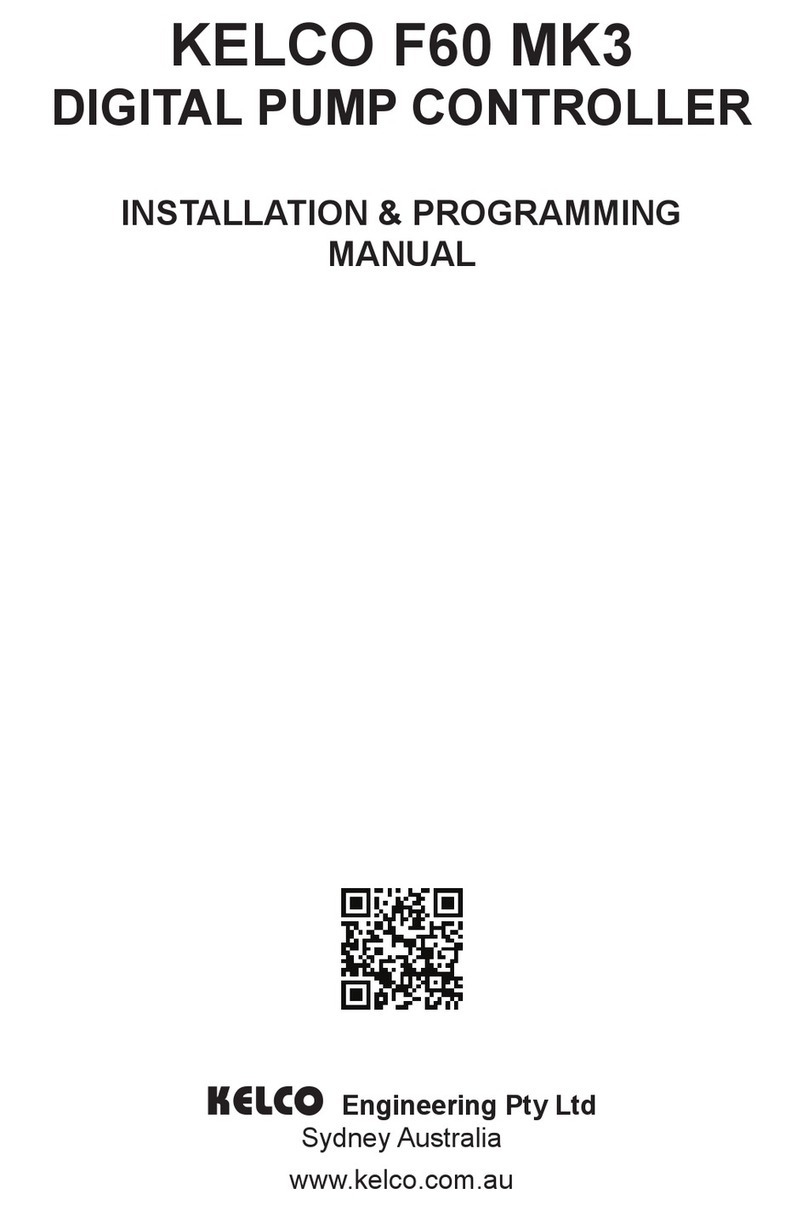The F27 controller is a conventional 1" BSP paddle flow
switch with a built in micro electronic controller that gives a
fully adjustable override on start function and an
independently adjustable paddle bounce ignore, or run on
function. A pump under the control of an F27 can start in
spite of no initial flow; it will ignore paddle bounce and can run
on for up to 5 minutes after flow stops. The run on function is
very useful for pressurising air cells and for pumping down
low yield bores.
The F30 pump controller operates in exactly the same way as
the F27 but in addition can accept an input from an external
pressure switch. The auxiliary input allows the F30 to read both
flow and pressure, and means that a pump under its control will
start automatically on a pressure drop as well as on a flow
demand. By monitoring pressure the F30 can identify a dry run
situation and shut down the pump. The F30 is very versatile
and can be used in many innovative ways in automatic tank
filling systems and in industrial pump control.
Time delay adjustment is by means of two 16 position rotary
switches. The time delays are individually programmed into
the controllers to give the rotary switches the following delays.
TIMER DELAY IN SECONDS
Start up Timer 0, 1, 2, 3, 4, 5, 10, 15, 20, 25, 30, 40, 50, 60, 120, 180
Run on Timer 0, 1, 2, 3, 4, 5, 10, 15, 20, 25, 30, 40, 50, 60, 180, 300
ADJUSTING TIMER SETTINGS
After adjusting the timer settings, the power to the controller
must be reset, that is, it must be turned off for a minimum of
0.5 seconds and then turned on again, before any changes
will take effect. This applies to all the controllers under all
operating conditions.
BASIC FLOW SWITCH FUNCTION
Both the F27 and F30 pump controllers have two independent
timers and are individually adjustable in steps. With both
timer dials set to zero, the controllers behave like a basic flow
switch and respond solely to paddle movement. On power up,
the only indication of activity will be the paddle light slowly
blinking red to indicate the power is on. If the paddle is
pushed into the on position, the output relay will energise and
the paddle light will turn green. If the paddle swings to the off
position the output relay de-energises immediately, the pump
will stop and the paddle light will revert to slowly blinking red.
OVERRIDE ON START
Set the run-on timer to zero. Set the start-up timer to 5
seconds. Reset the power for the change to take effect. On
power up the pump should start. The green timer light will
come on and stay on for the 5 seconds. If the paddle is
pushed into the on position the main green paddle light will
come on. At the end of the time out, the green timer light will
go out but if the paddle is on the pump will continue to run. If
the paddle then swings to the off position the paddle light will
turn off and the pump will stop. The start-up timer should be
set to a few seconds longer than the time it takes for the
paddle light to come on. By watching the timer and paddle
lights on power up, it is a simple matter to correctly set the
start-up timer.
RUN-ON TIMER
Set both the start-up and run-on timers to 5 seconds. On
power up the pump should start and the green timer light
should come on. If the paddle swings into the on position the
green paddle light will also come on. After 5 seconds the green
timer light will go out but the pump will continue to run and the
paddle light will remain green. If the paddle then swings to the
off position the green paddle light will go out and the timer light
will turn on red indicating the pump is running on the run-on
timer. The pump will continue to run while the run-on timer is
running. If the paddle swings back to the on position before the
run-on timer times out, the pump will continue to run
seamlessly. If the paddle fails to return to the on position within
the 5 seconds the pump will stop. The run-on timer’s red light
will go out and the green paddle light will also go out. Every
time the paddle swings back to the off position the run-on timer
will re-run and keep the pump running while it times out.
Set the pressure switch so its low-pressure contacts close on
a falling pressure at 8 to10M head or 80 to 100kPa above the
systems static pressure. In a pressurised system with a slow
bleed off the pressure switch contacts must close before all the
pressure leaches away. In addition, the pressure switches
differential setting must be set to a minimum. The object is to
have the pressure switch start the pump only and then for its
contacts to open as soon as the pressure starts to rise and
before the run-on timer times out. If the recommended bleed
valve and pressure gauge have been included in the
installation the job of adjusting the pressure switch and testing
the system is made very simple.
Given that the pressure switch has been correctly adjusted, an
F30 will function in the following manner. The paddle light will
blink slowly red indicating power is on. If the bleed valve is
slightly opened so as not to actuate the paddle then as soon
as the pressure reaches the cut in pressure of the pressure
switch and its contacts close, the pump starts. The blue
pressure switch light and the red run-on timer light will turn on.
As the pressure rises, the pressure switch contacts should
open, the blue light will go out and the pump will continue to
run under the control of the run-on timer. When the run-on
timer times out the pump will stop and the red run-on timer
light will go out. The paddle light will again blink slowly red.
The net effect has been to re-pressurise the system. If the
pressure is allowed to leach away again, the process will
repeat and then the F30 will return to standby mode.
It is important to note that the pressure switch is only used to
start the system, not to stop it as in a conventional pressure
system. The result is a constant pressure system not
constrained by the need to pump up to a high cut out pressure
simply because the pressure switch requires it. A multi stage
pump can be de-staged, or a pump with a substantially flat
constant flow curve can be selected to operate under the
control of the F30. This can result in substantial savings in
running costs and in many applications provide a highly
useful constant pressure flow, essentially free of the pressure
fluctuations that plague conventional pressure systems.
The first time the system is started, the pressure switch contacts
will be closed, due to lack of pressure. When power is applied,
the pressure switch will control the start-up timer and not the
run-on timer. Only after the initial time out of the start-up timer
does the pressure switch control the run-on timer. It is important
to understand this, because it means that the start-up timer will
need to be set to a value slightly longer than the time it takes for
TIMER SETTINGS
F27 PUMP CONTROLLER
F30 PUMP CONTROLLER
SETTING UP THE PRESSURE SWITCH
F30 DRY RUN PROTECTION
